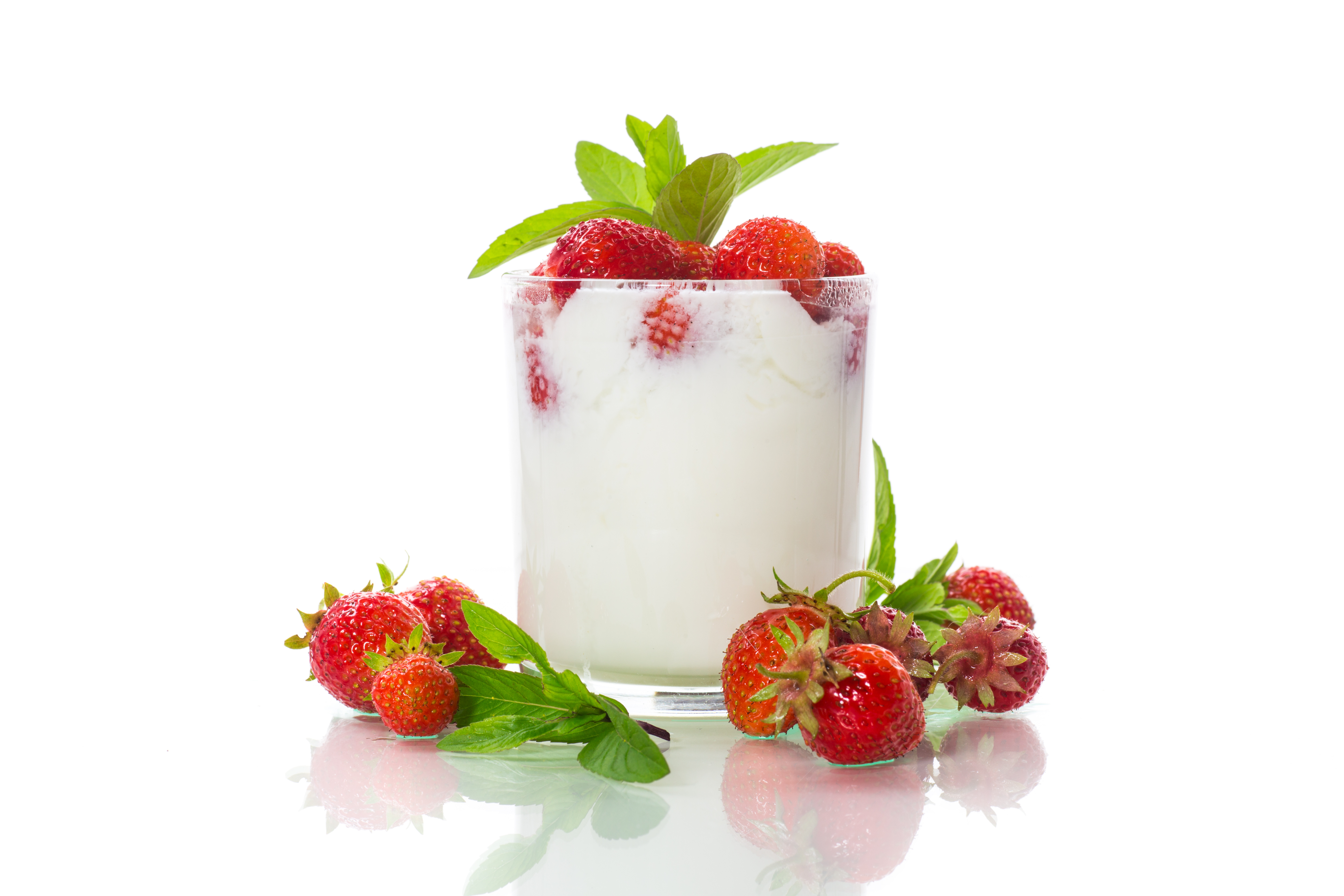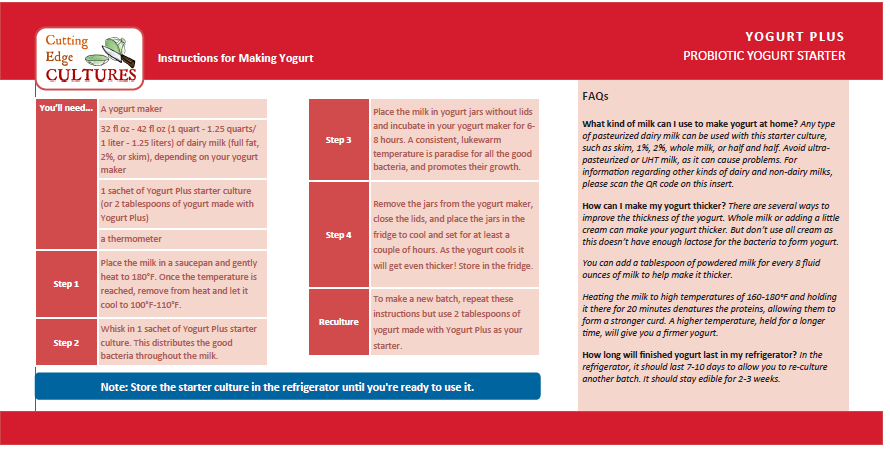Product Overview
Ingredients: S. thermophilus, L. delbrueckii, L. plantarum, L. reuteri, B. longum, non-GMO inulin
Contains live probiotics. Vegan. Dairy-free. Non-GMO.
Packaged in a facility that also handles products that may contain wheat, soy, eggs, milk, and fish.
The pouch contains 4 packets. Each packet makes 1¼ quarts of yogurt.
Make probiotic yogurt from scratch! Yogurt is a living, wholesome food that can easily be made at home.
Making your own yogurt gives you full control over the ingredients, and ensures that your healthy homemade yogurt has no added sugars, artificial flavors, or 'mystery' ingredients.
When made with a premium-quality starter culture such as our Yogurt Plus, your live probiotic yogurt can also contain many more probiotics than the store-bought versions*.
Our premium-quality Yogurt Plus starter culture is made with a unique blend of 5 beneficial species (S. thermophilus, L. delbrueckii, L. plantarum, L. reuteri, B. longum, non-GMO inulin).
Enjoy a healthy treat of homemade yogurt, with fresh and dried fruit, cereal, nuts, or vegetables.
*These statements have not been evaluated by the FDA. This product is not intended to diagnose, treat, cure or prevent any disease.
And there's a bonus, too! Once you've made yogurt using our Yogurt Plus starter, you can use some of it to culture your next batch! You can make up to 40 quarts of yogurt with this pack, just by reculturing!
This product is formulated to ship without refrigeration. Refrigerate or freeze it on receipt until you're ready to use it
Instructions for making Yogurt Plus
Makes: 1 - 1.25 quarts
Preparation time: about 30 minutes preps, 8 hours culturing
You’ll need:
- A yogurt maker
- 1 quart - 1.25 quarts (1 liter - 1.25 liters) of pasteurized or ultra-pasteurized dairy milk (skim, 1%, 2%, or whole milk). Goat milk may yield a thin result.
- 1 sachet of Yogurt Plus starter culture
- A thermometer
Steps:
-
Pasteurized milk: In a saucepan gently heat the milk to 180°F, then remove from heat and let cool to 110°F. Ultra-pasteurized milk: In a saucepan gently heat the milk to 110°F.
-
Whisk in 1 sachet of Yogurt Plus starter culture.
-
Place the milk in yogurt jar(s) without lid(s) and incubate in your yogurt maker for 8 hours. (Devices with adjustable temperatures should be set to 110°F.)
-
Remove the jars from the yogurt maker, let cool, close the lids, and place in the refrigerator to cool and set for at least a couple of hours. As the yogurt cools, it will get even thicker. Keep the finished yogurt in the refrigerator.
- Reculture: To make a new batch, repeat these instructions, except use 2 tablespoons of your finished yogurt as your starter culture (instead of a sachet).
Yogurt Plus FAQs
- What kind of milk should I use? Any type of pasteurized or ultra-pasteurized dairy milk, such as skim, 1%, 2%, or whole milk. Goat milk may yield thin results. Please note we haven’t tested shelf-stable dairy.
- Can I use non-dairy beverages? Our starter is primarily designed for dairy. Fermentation of non-dairy beverages is trickier. Our partners at Cultured Food Life have more experience with non-dairy versions. We haven't tried those ourselves, but it might be worth a look.
- Can I use raw milk? This is not recommended. It contains competing bacteria. If you want to try, you will find recipes on other websites. We haven’t tested these.
- How can I make my yogurt thicker? Higher fat content will make a thicker yogurt. Use whole milk or add a little Half & Half or cream (but don’t use all cream as this doesn’t have enough lactose for the bacteria to form yogurt). You can also strain the yogurt (keep the whey). Other options are adding 4 tablespoons of powdered milk per quart (or simply using one quart of Half & Half with 1 tbsp. of Prebio Plus), whisking well with the starter before fermentation. Heating the milk to 160-180°F and holding it there for 20 minutes (and then cooling it to 110°F before fermentation) may help denature the proteins, allowing them to form a firmer curd.
- How long will the finished yogurt last in my refrigerator? It should last 7-10 days to allow you to re-culture another batch. It should stay edible for 2-3 weeks
- Can I make larger quantities? Absolutely! Save time by making larger quantities. Remember to keep the ratios in proportion. For example, to make 2 quarts, double the quantities of all the ingredients; to make 3 quarts, triple the quantities, etc.
- Can I use more than 1 sachet of starter culture? Only if you’re making larger quantities (see question on larger quantities), otherwise you'll be crowding the bacteria.
- The Yogurt Plus starter contains L. reuteri bacteria. Why do we ferment at standard yogurt-maker temperatures if L. reuteri is heat-sensitive? Also, why do we ferment for only 8 hours, if L. reuteri should ideally ferment for 36 hours?
- Temperatures: The standard yogurt-maker temperatures are necessary for the other bacteria in the starter. While slightly higher than ideal for L. reuteri, these temperatures are still within survivability range for the L. reuteri given the short fermentation time (only 8 hours, compared to 36 hours). You could set the temperature to 106 F but this is lower than ideal for the other strains and may therefore yield a less than ideal result.
- Duration: 8 hours is the optimal duration for the other 4 strains that comprise the Yogurt Plus starter. (L. reuteri is one of five strains that make up this starter.) L. reuteri certainly ferments and multiplies in 8 hours, only to a more modest final count than in 36 hours. 8 hours is already a longer fermentation than many store-bought yogurts, which are often only fermented for a couple of hours. Yogurt Plus is a superb 'all-purpose' probiotic yogurt. If you make Yogurt Plus, there will be decent quantities of L. reuteri in the final product, along with the other 4 strains. If you specifically want a very high count of only L. reuteri, with no other strains at all, we created a separate product for that: LR Superfood, for which fermentation time is 36 hours.
- Is the temperature important when culturing yogurt? Yes. Stay with the recommended 110°F. Too warm and the bacteria will die. Too cool and the culturing will halt and likely not start again, resulting in a thin end-product that is not fully fermented.
- Why do I have to heat pasteurized milk? To kill any bacteria in the milk that might compete with the bacteria in the culture. It will also help denature the protein to form a thicker curd. Ultra-pasteurized milk should only be warmed up to 110°F (fermentation temperature).
- How many times can I reculture? For as long as your batch thickens and comes out pleasantly yogurty.
- I've been reculturing many times. How will I know it's time to start over and use a starter from a sachet? When your batch is too sour, or doesn't thicken as before, it's time to start over.
- What is a starter culture? A starter culture is a blend of bacteria that starts the culturing process, lowers the pH of the milk, and gives the resulting yogurt its tangy taste and firmer texture.
- Which strains are in the starter? The Yogurt Plus Starter contains a proprietary blend of selected strains of S. thermophilus, L. delbrueckii, L. plantarum, L. reuteri, B. longum, as well as non-GMO inulin.
- How long does an unopened sachet of starter culture keep in the refrigerator? The Best By date is printed on each pouch and on each sachet. Please keep the starter culture in the refrigerator or freezer until you're ready to use it.
- What should I do if the yogurt slightly curdles or if the whey separates from the curds? No problem! The yogurt is still good, just stir it to achieve a more even consistency.
- What should I do if the yogurt has not firmed after 8 hours of culturing? Leave it to ferment for a couple of hours longer. Do not poke or shake it while fermenting. Check again in 2 hours. It's normal for the first batch to come out thinner. The bacteria take a cycle or two to fully kick into gear. It's normal for the yogurt to have a pudding consistency. Yogurt Plus is not Greek yogurt, so it will never be as firm. Even if not fully firm, the yogurt will thicken when it cools down in the refrigerator. When making yogurt, follow the ingredients and instructions closely, including which milk to use, ratios and temperatures. Use a whisk, rather than a spoon, to mix the starter into the milk. Low-fat milk and goat milk will yield thinner results than full-fat milk. The starter is primarily designed to be fermented in dairy milk. Our instructions do not cover non-dairy versions. See also “How can I make my yogurt thicker?”
- How does the fat content of the milk affect the yogurt? There's a direct correlation between the fat content of the milk you use and the creaminess of the resulting yogurt. Whole milk will result in a rich, creamy yogurt; skim milk will produce a much less creamy texture.
- Can I freeze the yogurt? Yes, freezing does not kill the bacteria. You can make ice cream with it but expect the texture to be grainier/thinner. Please note, however, that we haven't tested batches recultured from a previously-frozen batch. If you plan on consuming/reculturing the yogurt within several weeks, you don't need to freeze it. Keep it refrigerated. Flavor and texture may change over time.
- How should I store the yogurt while I'm away? If you plan on consuming/reculturing the yogurt within several weeks, keep it in the fridge. Flavor and texture may change over time. Viability will eventually reduce too, but if your absence does not exceed several weeks, your ferment should kick back into gear once fresh milk is introduced. When you get back, check if it's still good, and reculture a small quantity (1 liter/1 quart). You may need to extend culturing time and/or use more than 2 tablespoons of your finished yogurt as a starter, to let the bacteria catch up by proliferation. It may take a few cycles to return to full vigor. If the new batch turns out fine, keep using it. If not, discard, and use a new starter from a sachet to start over. Please note that although freezing does not kill the bacteria, we haven't tested batches recultured from previously-frozen batches.
- Can I use metal utensils and lids to handle ferments? Overall yes, because the metal used in utensils and food-grade lids is most probably acid-resistant, and the utensil is not going to touch the ferment for that long. Metal lids can be used provided that they are acid-resistant and do not directly touch the fermented product for an extended period of time. Opt for the type of lids with a waxy interior, used for pickles, for example. If that interior is corroded though, better not use them. Also: the jar should not be full all the way to the top, to avoid direct contact between the ferment and the lid. There's no problem using stainless steel in the preparation stage, before fermenting.
- Can I use a blender? Better not. Blending could be too forceful for the live microorganisms and may result in the shearing of many of them, in which case you will get fewer live bacteria. Whisking, on the other hand, is fine. If you make a smoothie, we recommend stirring the yogurt into the smoothie after the rest of the ingredients have been blended, or keeping the blending to a minimum and using the lowest speed possible.
- When should I add flavorings such as fruit, sweeteners, etc.? Add these after the yogurt is refrigerated or before consumption.
- Why is the starter shipped without ice? See "I live in a hot place. Is the starter still active after being shipped unrefrigerated in hot weather?"
- Do you ship to Hawaii / Alaska / Puerto Rico? Yes. Shipping fees to Hawaii, Alaska, and Puerto Rico are the same as to any address within the contiguous USA. We use ambient shipping (non-refrigerated and without ice). Our starters are designed to remain active for several weeks in transit in hot weather, without refrigeration or ice. The formula and the packaging provide excellent protection for the live strains. See "I live in a hot place. Is the starter still active after being shipped unrefrigerated in hot weather?"
- I live in a hot place. Is the starter still active if it's shipped unrefrigerated in hot weather? Yes. Our starters are not affected by heat in unrefrigerated transit. They are designed to remain active for several weeks in hot weather, including heatwaves, without refrigeration or ice. The formula and packaging provide excellent protection for the live strains. They are freeze-dried and not heat-sensitive in the sealed packet. We have thoroughly tested this. For this reason, we use ambient shipping, which is significantly less costly for the customer. We keep the starters in a cold warehouse until orders are shipped, and when your order is shipped we send you a tracking number so that you can see when it is due to arrive. Once received, the starter should be refrigerated or frozen for the longterm, and you can use it as normal. It's normal for the first batch to come out thinner. The bacteria take a cycle or two to fully kick into gear. This has nothing to do with the unrefrigerated shipping. See also "I forgot to refrigerate the starter. Is it still active?"
- I forgot to refrigerate the starter. Is it still active? This depends on how long the starter has been left at ambient temperature and if the Best By date is still valid. The starter is designed to remain active for several weeks (and depending on ambient temperatures, even longer) at room/warm temperatures (usually for transit purposes). The formula and the packaging provide excellent protection for the live strains. If the delay is much longer and the temperatures are very high, the viability may be affected. That said, reduction in viability is a slow process that does not happen immediately, even past Best By date. You could try compensating for the possible decrease in viability by increasing the ratio of starter to dairy (for example, by using 2-3 sachets to make one quart, leaving the rest of the ingredients unchanged), and by fermenting for a little longer if needed, to let the bacteria catch up by proliferation over time. See instructions. Your batch should thicken and come out pleasantly yogurty. There's no harm in consuming inactive bacteria; this is equivalent to consuming no bacteria at all. If all goes well, you could later use some of your ready batch to make future larger batches. Remember to keep the starter refrigerated (or frozen) until you're ready to use it. See also "I live in a hot place. Is the starter still active after being shipped unrefrigerated in hot weather?"
- What are the starter's caloric/nutrition facts? These are printed on the back of the pouch. But overall, our starters contain such minuscule quantities of powder, that they are too tiny to have any impact on the final result's caloric values. Our starters come in sachets of 1g - 3g of powder (depending on the starter), most of which, apart from the live strains, is either a carrier fiber containing no caloric value, or a trace of a natural sugar containing only a negligible value. When these teensy quantities of 1g - 3g are added to a quart of dairy, the starter's original caloric values, if ever there were any, become entirely diluted in the overall mass, and are practically non-detectable. The final result's nutritional values of calories/fats/carbs etc., come directly from the dairy that the starter was added to, not from the starter itself. For example, if you use whole milk, it will add more fat to your final result than skim milk.
- Is the starter gluten-free/soy-free/dairy-free/lactose-free/vegan? Although the starter contains no gluten, no soy, no animal products, and no dairy (and hence no lactose), it is designed to ferment dairy, and is packaged in a shared facility that also handles products that may contain wheat, soy, eggs, milk, and fish.
- Is the starter certified Kosher? No. Our starters are not certified Kosher.
- Where is the starter made? In the USA.














